Book contents
- Frontmatter
- Contents
- Preface
- Section 1 Clinical surgery in general
- Section 2 Thorax
- Section 3 Trunk
- Chapter 7 Applied surgical anatomy
- Chapter 8 Applied surgical physiology
- Chapter 9 The abdominal wall
- Chapter 10 The abdominal aorta and abdominal aortic aneurysms
- Chapter 11 The oesophagus, stomach and small bowel
- Chapter 12 The liver, biliary tree and pancreas
- Chapter 13 The spleen: splenic trauma and splenectomy
- Chapter 14 The large bowel
- Chapter 15 The rectum and anus
- Chapter 16 The kidneys and genitourinary system
- Bibliography
- Index
Chapter 10 - The abdominal aorta and abdominal aortic aneurysms
Published online by Cambridge University Press: 05 February 2012
- Frontmatter
- Contents
- Preface
- Section 1 Clinical surgery in general
- Section 2 Thorax
- Section 3 Trunk
- Chapter 7 Applied surgical anatomy
- Chapter 8 Applied surgical physiology
- Chapter 9 The abdominal wall
- Chapter 10 The abdominal aorta and abdominal aortic aneurysms
- Chapter 11 The oesophagus, stomach and small bowel
- Chapter 12 The liver, biliary tree and pancreas
- Chapter 13 The spleen: splenic trauma and splenectomy
- Chapter 14 The large bowel
- Chapter 15 The rectum and anus
- Chapter 16 The kidneys and genitourinary system
- Bibliography
- Index
Summary
What is the commonest site of aneurysm formation?
Prior to the discovery of penicillin, the most common type of aortic aneurysm was of the aortic arch secondary to syphilis. However, in modern practice the infrarenal abdominal aorta (see Figure 10.1) is the most commonly affected. The most common peripheral aneurysmal artery is the popliteal artery.
How may aneurysmal dilatation of the aorta be classified?
By convention, aortic aneurysms are divided into:
Ascending and descending thoracic aortic aneurysms (TAA),
Thoraco-abdominal aortic aneurysms,
Suprarenal aortic aneurysms (involving the renal arteries, coeliac axis and the superior mesenteric artery – the visceral segment),
Juxtarenal aortic aneurysms (the aneurysm starts below the renal arteries, but necessitates clamping above them),
Infrarenal aortic aneurysms.
- Type
- Chapter
- Information
- MRCS Revision Guide: Trunk and Thorax , pp. 74 - 79Publisher: Cambridge University PressPrint publication year: 2012



